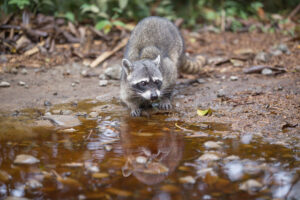Wildlife Removal Near Water
As dedicated wildlife removal specialists, we at Bay Area Wildlife have encountered numerous challenges throughout our careers. One of the most complex and delicate situations arises when wildlife finds its way near water bodies. These scenarios demand a unique set of skills, considerations, and strategies to ensure the safe and effective removal of the animals while preserving their natural habitat. At Bay Area Wildlife, we’ve been providing animal removal services for years and wanted to talk about what removing wildlife near water entails.

Assessment and Observation
When called upon to address wildlife issues near water, the initial step is a thorough assessment of the situation. The area surrounding the water body is observed, paying close attention to animal tracks, burrows, nesting sites, and signs of disturbance. Identifying the specific species involved is crucial, as it helps determine the most suitable removal techniques while minimizing potential harm to both the animals and their habitat.
Environmentally Friendly Approach
In cases where wildlife poses no immediate threat to human safety or property, our approach focuses on being environmentally friendly. Instead of hasty removal, we aim to create a harmonious coexistence between humans and wildlife. Implementing strategies like habitat modification and exclusion techniques can discourage animals from venturing too close to human-populated areas, thereby reducing the need for removal.
Non-Lethal Techniques
To remove wildlife near water bodies, non-lethal techniques are often the preferred approach. Live trapping is a common method, involving the use of humane traps designed to safely capture the animal. These traps are strategically placed near the water’s edge, taking into account the species’ behavior and patterns. Once captured, the animals are relocated to a suitable environment away from human habitation, ensuring their safety and preserving the balance of local ecosystems.
Environmental Considerations
The proximity to water requires additional precautions during wildlife removal. Animals like beavers, muskrats, or waterfowl may construct nests, burrows, or dens near the water, which can have a significant impact on the surrounding environment. Removing these structures must be approached with care, ensuring minimal disruption to the water’s flow, vegetation, and the overall ecosystem. Collaboration with environmental agencies and experts may be necessary to execute such tasks successfully.
Safety Measures
The safety of both the wildlife removal specialists and the animals involved is paramount. Working near water bodies introduces additional risks such as slippery surfaces, potential waterborne diseases, or encounters with aggressive animals. Personal protective equipment (PPE) like gloves, boots, and, if necessary, waders, helps mitigate these risks. Additionally, a thorough understanding of animal behavior, including signs of aggression or stress, is vital for ensuring a safe working environment.
Prevention and Education
While the removal of wildlife near water is essential in some cases, prevention and education play key roles in minimizing such situations. Public awareness campaigns, highlighting the importance of maintaining a respectful distance from wildlife and the consequences of habitat encroachment, can help foster coexistence. Educating communities about waste management, proper disposal of food, and securing trash receptacles significantly reduces the likelihood of attracting wildlife to water-adjacent areas.
Work with a Professional Animal Removal Company
The process of removing wildlife near water requires a delicate balance between conservation, human safety, and responsible animal relocation, and is a job best left only to a professional. At Bay Area Wildlife, we’ve been in the wildlife removal game for a while now and can help you! Reach out to us at (410-829-6368) or send us a message online!

 302.500.0181
302.500.0181  410.829.6368
410.829.6368